Qatar Museums will present The curious desert, a new exhibition conceived by Olafur Eliasson for a site in the desert outside of Al Thakhira Mangrove Reserve and for the galleries of the National Museum of Qatar in Doha, from 19 March through 15 August 2023. Located inside and outside the museum, the exhibition includes new site-specific works that continue to explore the Icelandic-Danish artist’s abiding interests in light and colour, geometric studies, ecological awareness and more-than-human relationships. The exhibition is presented as part of Qatar Creates, the year-round national cultural movement that curates, promotes, and celebrates the diversity of cultural activities in Qatar.
Her Excellency Sheikha Al Mayassa bint Hamad bin Khalifa Al Thani, Chairperson of Qatar Museums, said, “The curious desert by Olafur Eliasson illustrates the power and problemsolving ability of art. Olafur’s profound body of work, including the new installations in the Qatari desert, opens an important dialogue about the environment, one of the most pressing topics of our time, in the context of our nation’s natural landscapes. This exhibition is unique in its presentation, which exists both inside and outside of the National Museum of Qatar, to further demonstrate how art is not confined to galleries, but is around us, everywhere, to inspire and educate.”
Olafur Eliasson stated, “It is an extraordinary opportunity to create artworks for the sabkha near Al Thakhira Mangrove Reserve. The sun, the wind, the nearby lagoon saltwater – they all help co-produce the artworks that visitors will encounter here. I hope the artworks in turn may sensitise people to the singular landscape and to the more-than-human agencies at work. The other half of my exhibition, at the National Museum of Qatar, is an assembly of embodied thoughts and actions from over 25 years of working as an artist. These two naturalcultural sites enrich each other – together they make up The curious desert.”
Located in a sabkha habitat some 64 kilometres northeast of Doha, near the Al Thakhira Mangrove Reserve, twelve temporary pavilions enclose a series of new, experimental artworks that respond to the ephemeral natural phenomena of the local environment, such as sunlight, wind and water.
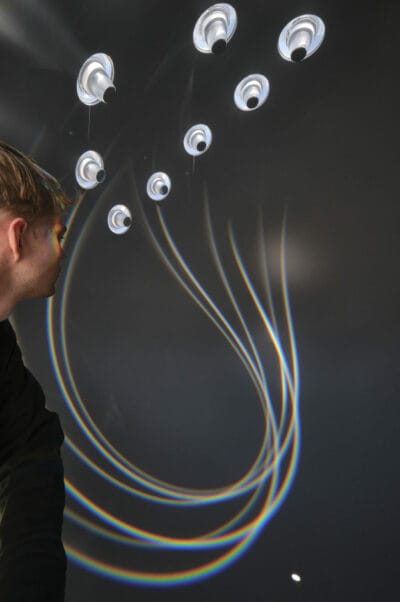
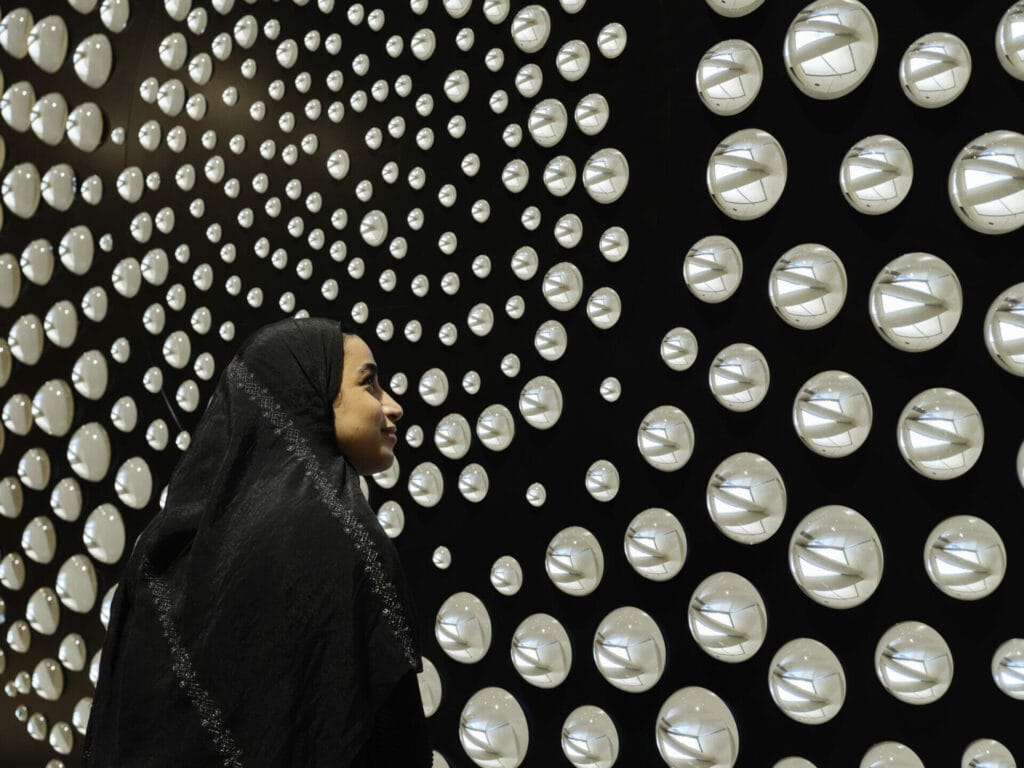
The first three outdoor pavilions explore optical phenomena, making use of rainbows, shadows and mirrors to create mesmerizing effects, while pavilions five through seven contain innovative drawing machines that enlist the elements of the sabkha habitat to create artworks that will later be displayed within the exhibition at the National Museum of Qatar. The final three pavilions bring this environment into dialogue with others, with materials such as obsidian and glacial mud from Iceland. Among the projects located in the twelve desert pavilions are:
● Rainbow incubator – 11 prisms, arranged along the top of a reflective sphere according to the path of the sun at Al Thakhira, bend and break the daylight entering the sphere, causing it to appear at different times of the year as a perfectly circular rainbow.
● Saltwater-drawing observatory – Two circular canvases – one white and the other black – turn slowly on motors as water, mixed with black and white pigments respectively, drips down onto the spinning surfaces. The wind causes the drawing utensil to move across the surface of the turning page, leaving undulating marks upon the surface. The drawings, portraits of the weather conditions at the location, are then periodically shown at The National Museum of Qatar.
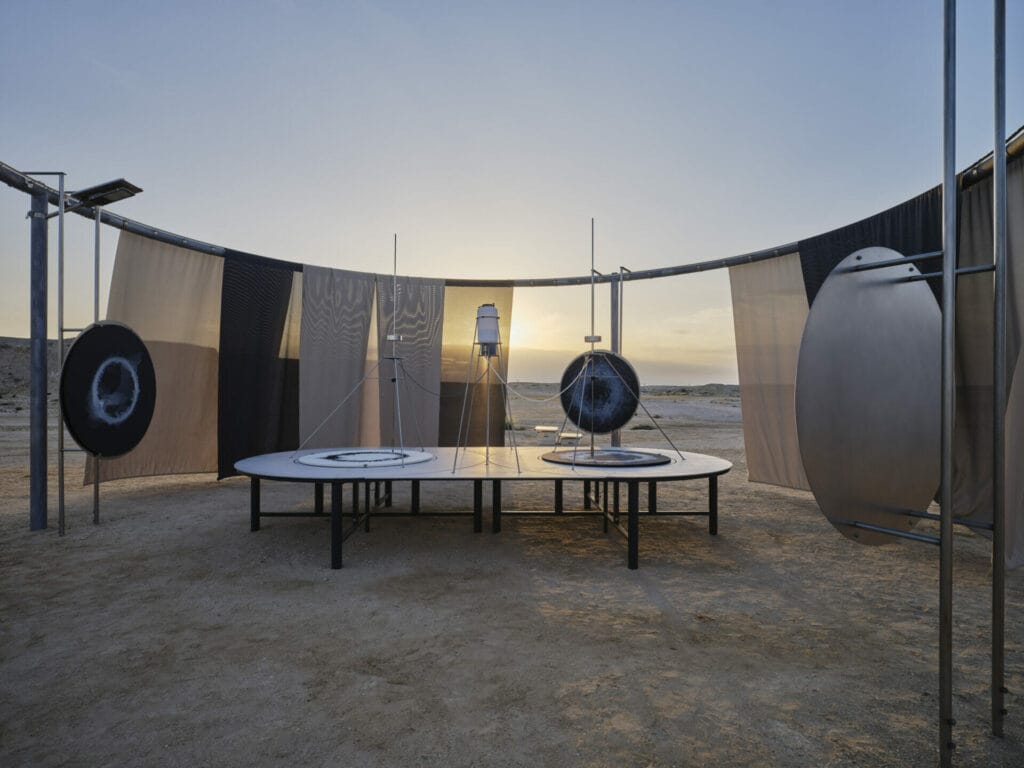
● Solar incense burner – A single glass sphere uses the rays of the sun to ignite a selection of scents typical of Qatar and the region – oud, musk, and amber, among others. Each burns for exactly one hour, functioning as a clock by marking the times of day in a variety of scents.
● Your obsidian garden – Inspired by Eliasson’s hikes through volcanic obsidian fields in the Icelandic highlands, the artwork in this pavilion features black, shiny obsidian that stands out in stark contrast to the sandy ground, appearing to have erupted from beneath the desert.
Eliasson and Qatar Museums worked with an ecologist to conduct an extensive survey of the site near Al Thakhira to ensure the protection of its native plants and non-human inhabitants, such as the Arabian Red Fox.
Inside the National Museum of Qatar, an extensive presentation of works from throughout the artist’s career invites viewers to situate themselves anew in relation to expansive light installations, photo series from Iceland, complex geometric studies, watercolours, optical devices, and a sprawling research map. Works featured at the National Museum include:
● The living lighthouse, 2023 – a new installation comprising broad bands of colourful light that crawl across the walls of this circular room, wrapping visitors in a vibrant, ever-changing light installation.
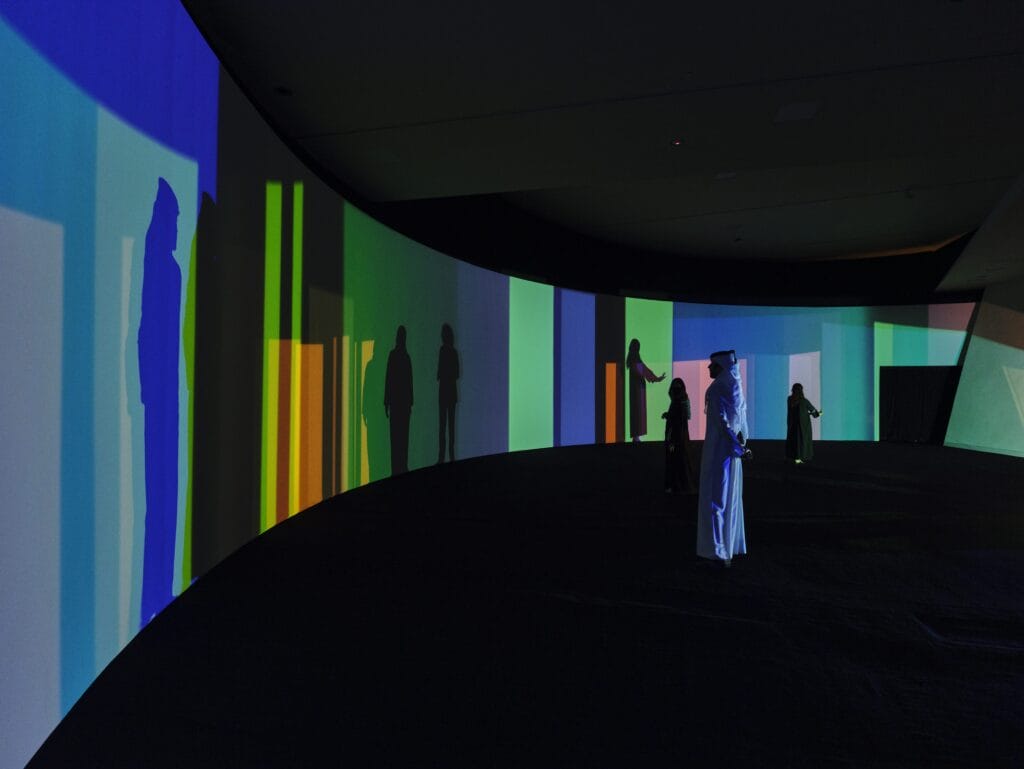
● The Research map, 2019- – a sprawling pin wall that charts the research and ideas that have inspired Eliasson and his studio in recent years. The map can be seen as a space of micro-storytelling, where seemingly unrelated contents vibrate next to each other and create new meaning.
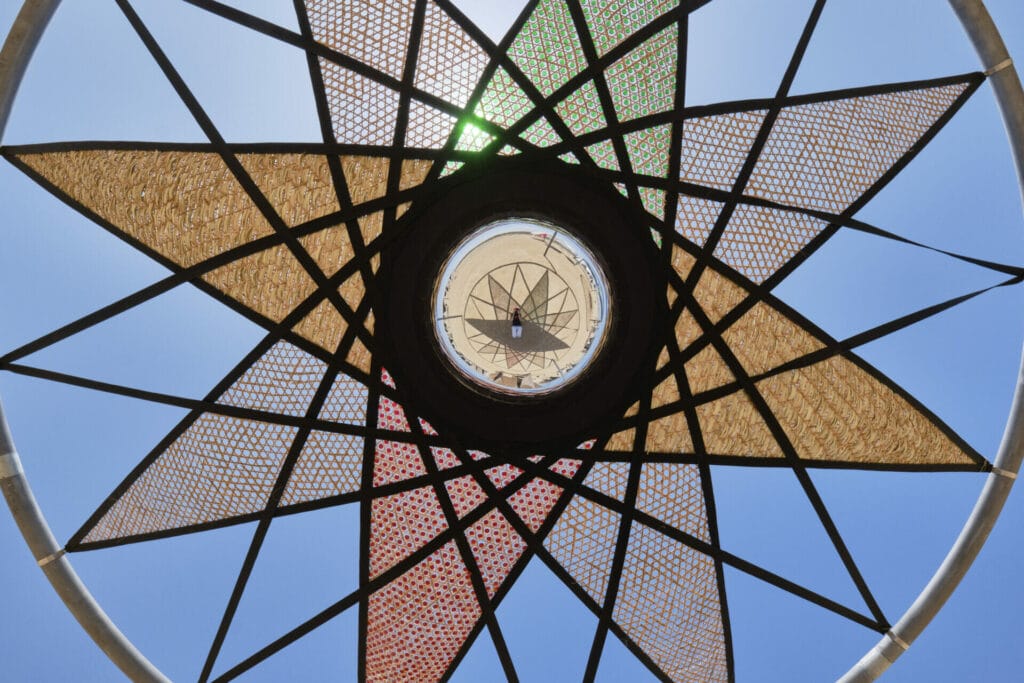

● Photography series depicting the natural landscapes of Iceland – including The glacier melt series, 1999/2019, 2019, The inner cave series, 1998, and The horizon series, 2002 – selected by the artist with the landscape of Qatar in mind.
● Artworks created by drawing and painting machines installed outdoors near the Al Thakira Mangrove Forest.
The presentation of The curious desert follows Qatar Museums’ October 2022 unveiling of Eliasson’s outdoor installation commissioned for the desert near the Ain Mohammed heritage site in Northern Qatar. The artwork, Shadows travelling on the sea of the day (2022), continues the Icelandic-Danish artist’s longstanding exploration of the interplay between human perception and the natural world.
A two-part film created by Tigerlily Production for Studio Olafur Eliasson and Qatar Museums captures the development of Eliasson’s installation Shadows travelling on the sea of the day and his exhibition The curious desert. The film created for Shadows travelling on the sea of the day will be on view at the Mohammed Jassim Al Khulaifi Library of The National Museum of Qatar, together with a special reading room dedicated to Eliasson, that collects a broad selection of catalogues covering the artist’s production, starting from the his first solo exhibition in the nineties running up to the present. The screening of the premier of the film about The curious desert will be announced during the course of the exhibition.
A richly illustrated publication – documenting the exhibition and its development in photographs and artist sketches – will be available from late summer. The book will contextualise the exhibition, with a special focus on Eliasson’s site-specific installations in the Qatari desert. Throughout this publication, themes explored will raise pertinent questions around the global climate emergency, including vulnerability, responsibility, and urgency. The book will be available in English and Arabic.
About The curious desert A free shuttle bus to the outdoor location will run once a week. Starting from 25 March the bus will depart from the National Museum of Qatar every Saturday.
● March to May – departing from the National Museum at 9:00AM, returning at 12:00PM.
● June to August – departing from the National Museum of Qatar at 4:00PM, returning at 7:00PM. Bus capacity is limited and will be available on a first-come, first-served basis. For further details, please visit the NMoQ website.
Catalogue
A richly illustrated publication – documenting the exhibition and its development in photographs and artist sketches – will be available from late summer. The book will contextualise the exhibition, with a special focus on Eliasson’s site-specific installations in the Qatari desert. Throughout this publication, themes explored will raise pertinent questions around the global climate emergency, including vulnerability, responsibility, and urgency. The book will be available in English and Arabic.
Mayssa Bint Hamad Bin Khalifa Al Thani, Chairperson of Qatar Museums, Doha Film Institute, Reach Out to Asia, and Qatar Leadership Centre, H.E. Mr. Ahmed Al-Sada, Assistant Undersecretary for Climate Change, and Ghanim Al Ghanim, CEO of Al Hosh Gallery. On the occasion of the exhibition Olafur Eliasson: The curious desert at the National Museum of Qatar, the cross-disciplinary discussion looked at the ways in which art and culture strive to inspire positive change when confronted with the urgency of the climate crisis. The second talk, ‘Art and the Environment: Awareness and Action’ between Eliasson, Mohammed Omar Al Bader, from the Climate Change Department, Ministry of Environment and Climate Change; Dr. Aspa D. Chatziefthimiou, Ecologist and Environmental Consultant at NMoQ; Reem Al Sehlawi, Associate Director of the Arab Youth Climate Movement; and Neema Githere, writer, artist, and grassroots theorist, from the USA/Kenya, centred around our entanglements with natural environments in the context of the climate emergency and addressed the complex ways in which we can hear and respond to the needs of many – humans and nonhumans alike. The panel were recorded and will be available on Qatar Creates. Carbon footprint report The full carbon emissions report for Olafur Eliasson: The curious desert at the National Museum of Qatar will be available after the exhibition closes. Final results and offsetting partners will be published on Studio Olafur Eliasson website and the NMoQ website. Studio Olafur Eliasson is dedicated to seeking sustainable solutions in all aspects of art-making and studio operations. While there is no substitute for cutting carbon emissions, we opt to offset those we cannot currently avoid.
About Olafur Eliasson
The works of artist Olafur Eliasson (IS/DK, b.1967) explore the relevance of art in the world at large. Since 1997, his wide-ranging solo shows – featuring installations, paintings, sculptures, photography, and film – have appeared in major museums around the globe. In 2003, he represented Denmark at the 50th Venice Biennale, and later that year he installed The weather project at Tate Modern’s Turbine Hall, London. He returned to Tate Modern in 2019, for In real life, a wide-ranging survey exhibition of his artistic practice over the past twentyfive years. Olafur Eliasson: Symbiotic seeing appeared at Kunsthaus Zürich from January to March 2020, and Sometimes the river is the bridge was shown at the Museum of Contemporary Art Tokyo from April to September 2020. In the autumn of 2022 Eliasson presented two solo exhibitions in Italy: Nel tuo tempo (In your time), at Palazzo Strozzi, Florence, and Orizzonti tremanti (Trembling horizons), at Castello di Rivoli, Turin. Eliasson’s projects in public space include The New York City Waterfalls, 2008; Fjordenhus, Vejle, 2018; Ice Watch, 2014; and most recently Shadows travelling on the sea of the day, 2022. In 2012, Eliasson set up the social business Little Sun, and in 2014, he and Sebastian Behmann started Studio Other Spaces, an office for art and architecture.
Artist’s statement for The curious desert at The National Museum of Qatar
Entering a museum is a way of stepping closer to society, to the realities that we live in. In a museum, you are able to see things in higher resolution. You become more focused, aware. Your senses become more alert; your body attuned; your mind open. What you encounter are most often artefacts or works of art. In my artistic practice I try to hand over the authority of deciding what is important in these encounters to the visitors. My artworks strive to embody transformation rather than stability and being. The curious desert, my new exhibition conceived for the landscape near Al Thakhira Mangrove Forest and for the galleries of the National Museum of Qatar, is no different. It is not a stable representation or a model of reality; it is reality. Your experience of it changes with the time you spend in it. The outdoor part of The curious desert resembles a desert laboratory, created especially for this exceptional landscape, known as a sabkha – a low plain covered in salt and other mineral deposits left over from evaporated sea water, a rich landscape bearing, as it were, the presence of absence. It consists of twelve temporary pavilions with various artworks in the shape of experimental setups, many emerging over the course of the day or over the duration of the exhibition. For some of these I have enlisted the sunlight, wind, and water to coproduce the artworks. Other pavilions host glacial sediments, remnants of oil spills, and salt crystals left over from evaporating lagoon water. Wandering in and out of the gathering of tent-like pavilions becomes an individually crafted journey. This allows you to sensitise yourself to the desert surroundings, to naturally occurring phenomena, and to the emergence of art through processes that draw on more-than-human collaboration. Working in the seemingly barren landscape of Qatar reminds me of time I’ve spent in the black-sand deserts of Iceland, a space I’ve always considered a laboratory setting for artistic experimentation. Both sites are subject to extreme temperatures; both are fragile and challenge your sense of time passing. Responding to this fragility in Qatar has meant working closely with the museum team and engaging in dialogue with a local expert on vulnerable sites, who has produced an ecological survey of the Al Thakhira area. This has given me the opportunity to learn about and minimise the ecological footprint of the exhibition on the landscape; to acknowledge the presence of non-human inhabitants, like the Arabian Red Fox. My artistic laboratory at Al Thakhira and my permanent installation, Shadows travelling on the sea of the day, near Fort Zubarah and the village of Ain Mohammed are complemented by a series of meditative light installations, geometric models, photo series, watercolours, and a sprawling research map inside the National Museum of Qatar. These artworks, like their outdoor counterparts, ask how we use vision and movement to make sense of our worlds; to make invisible phenomena visible and palpable; and to collect knowledge, engage in critical reflection, and construct worlds based on the stories that we live each day. Together, these naturalcultural sites enrich each other. Together they make up The curious desert. The artworks that inhabit them are an assembly of embodied thoughts and actions, each entangled with the presence of their fellow artworks. – Olafur Eliasson





